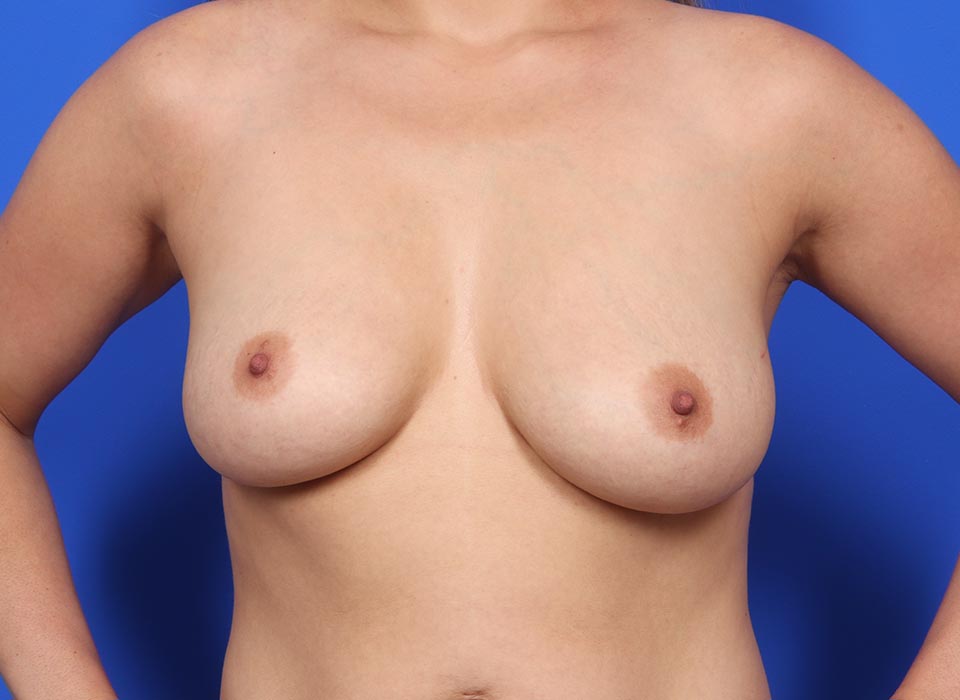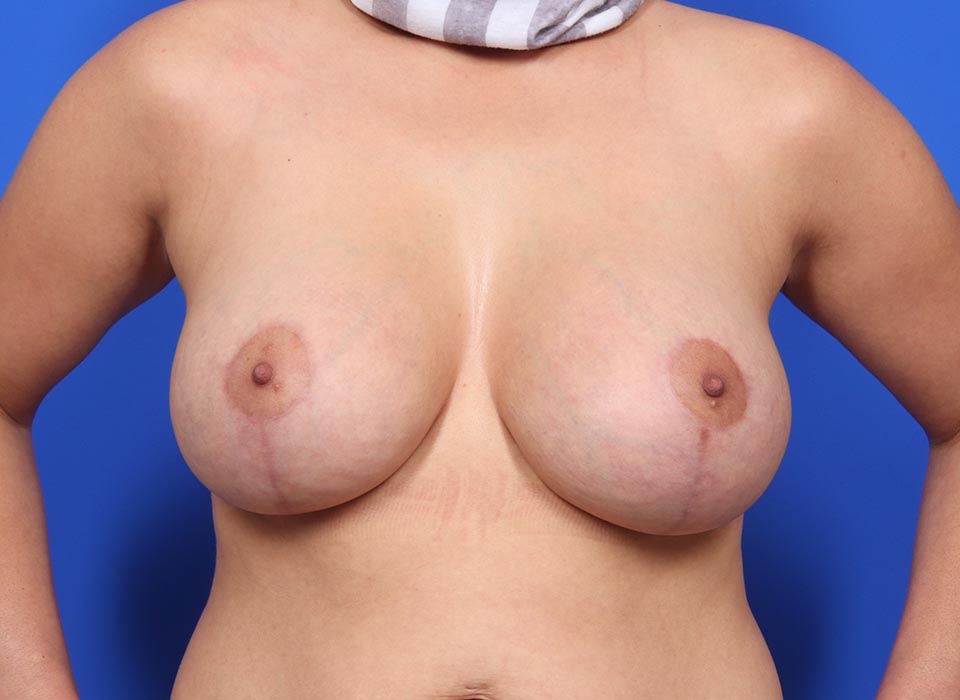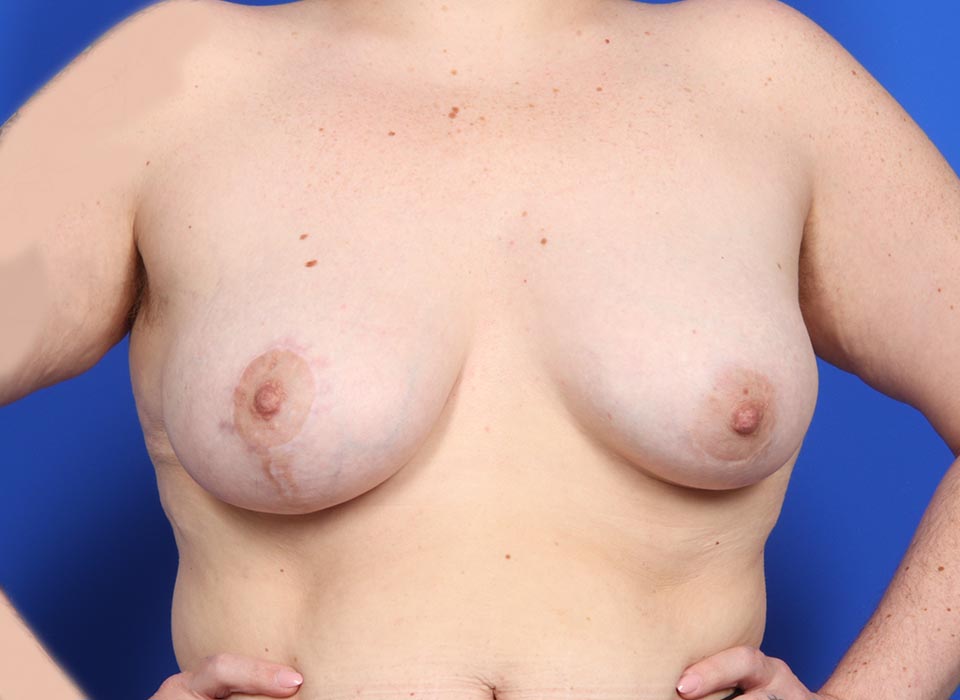
Breast Asymmetry

It’s very common for women to have asymmetrical breasts, or breasts that appear to be a slightly different size or shape. In fact, studies show that the majority of women, up to 88%, have some level of
Trusted Source
Abstract: Breast Asymmetry in Women Requesting Plastic Surgery of the Breast
Cruz NI
Go to Source
breast asymmetry
. In most women, breast asymmetry is minor and barely noticeable (if at all). However, women whose breasts differ by a cup size or more or whose breasts are markedly asymmetrical may experience a lack of confidence, difficulty finding clothes that fit properly, or other problems that negatively impact their daily lives. For these women, Dr. Sarah Mess offers a range of breast asymmetry correction options at her Columbia and Baltimore Maryland plastic surgery practice. Dr. Mess has earned a stellar reputation for delivering superior patient care and consistently stunning results, and she takes great pride in helping women achieve the shapely results they’ve always desired.

Causes of Breast Asymmetry
There are a number of factors that may contribute to the appearance of breast asymmetry, such as:
- Differences in breast volume
- Differences in position of inframammary crease
- Differences in the position or size of areolas
- Differences in shape
- Differences in quantity of skin
The most common causes of breast asymmetry are one-sided underdevelopment of the breast bud, tuberous breast, and prior breast surgery. Certain congenital conditions such as Poland Syndrome and Pectus Excavatum are also known to cause asymmetrical breasts.
Trusted Source
Poland Syndrome
U.S. National Library of Medicine
Go to Source
Poland syndrome
is characterized by one-sided underdevelopment of ribs, breast and upper extremity. Pectus excavatum is where the breastbone is sunken into a person’s chest.
Trusted Source
Pectus Excavatum
Mayo Clinic
Go to Source
Pectus excavatum
becomes more pronounced during adolescence and can cause both physical and cosmetic concerns.
Underdevelopment of Breast Bud
During adolescence, the breasts development may occur asymmetrically. The outcome may be only a half cup difference or multiple cup sizes. The underdeveloped side has a smaller volume, tighter skin-envelope, higher inframammary crease, narrower chest width, less prominent ribs, higher nipple position, and smaller areola. After pregnancy and breast-feeding, the asymmetry may become more exaggerated.
Tuberous Breast
Tuberous breasts are characterized by breasts that develop in a tubular rather than round shape. Tuberous breasts usually have narrow bases and enlarged, protruding areolas. The lower pole of the breast may be constricted or shortened so the nipple points downward. The tubular breast may be elongated like a tube sock. Sometimes one breast is more affected than the other.
Trusted Source
he Prevalence of Tuberous/Constricted Breast Deformity in Population and in Breast Augmentation and Reduction Mammaplasty Patients
Aesthetic Plast Surg
Go to Source
According to recent medical research
, up to one-half of women who pursue cosmetic breast surgery have a degree of tuberous breast. Many of the women who come to Dr. Mess for treatment of asymmetrical breasts have an underdeveloped breast on one side and tuberous breast on the opposite side.
Prior Breast Surgery
Breast biopsy and lumpectomy can reduce the size of one breast as well as create scar tissue that elevates one-side. Mastectomy for breast cancer causes the most severe asymmetry despite reconstruction. Some causes of breast asymmetry may be attributed to poor outcome of prior breast augmentation procedures or aged breast implants.

Breast Asymmetry Correction Options
Dr. Sarah Mess understands that each of her patients has unique physical and cosmetic concerns to address when seeking breast asymmetry correction. At her practice in Columbia, Maryland, Dr. Mess and her team always take the time to fully understand each patient’s needs and goals so that in order to customize the ideal treatment plan for her specific case. Dr. Mess then provides the patient with a high-resolution, three dimensional simulation of projected results of breast asymmetry surgery using VECTRA® 3D Imaging.

Fat Transfer to Breast
Fat transfer breast augmentation is Dr. Mess’ preferred method of treatment for asymmetrical breasts. During this procedure, Dr. Mess uses liposculpture to harvest fat from one or more areas of the body (typically the abdomen, flanks, or thighs). She then reintroduces that fat into one or both breasts.
Fat transfer allows Dr. Mess to adjust breast size and positioning with greater accuracy than is sometimes possible with the placement of breast implants, and it creates more permanent enhancement that looks and feels natural. An added benefit of fat transfer to correct breast asymmetry is that patients are also able to enjoy the results of liposuction to other parts of the body, creating a more proportionate and shapely appearance to the figure.
Breast Augmentation
If one breast is significantly larger than the other, breast asymmetry may be corrected with Breast Augmentation. Using a silicone or saline implant to increase the size of the smaller breast can create a more harmonious, balanced appearance. According to the patient’s wishes, Dr. Mess may use a slightly smaller implant on the opposite breast to enhance symmetry while creating an overall larger bust.
Breast Lift, Breast Augmentation With Lift
Some patients with breast asymmetry experience more sagging on one side than the other. In these cases, Dr. Mess may recommend a Breast Lift or Breast Augmentation with Lift to elevate the breast and nipple and create a fuller, firmer appearance.
Breast Reduction
If a patient with breast asymmetry prefers a smaller bust, Dr. Mess may recommend a Breast Reduction procedure for the larger breast. This type of asymmetrical breast correction can yield natural-looking results that may last longer than other options.
Breast Implant Revision
While the majority of Dr. Mess’ patients pursue breast asymmetry correction at her Columbia, MD practice as a result of natural or congenital factors, Dr. Mess’ reputation and expertise have also attracted a significant number of patients seeking Breast Implant Revision to correct asymmetry. Over time, breast implants may lose volume, rupture, or deflate, causing cosmetic changes. Poorly-positioned breast implants may also contribute to asymmetry, as can capsular contracture (the hardening of the breasts resulting from built-up scar tissue). All of these issues can be corrected with Breast Implant Revision.
Asymmetrical Breast Surgery FAQs
Is breast asymmetry correction covered by insurance?
In the vast majority of cases, surgery to correct breast asymmetry is considered to be elective and is not covered by medical insurance. Dr. Mess believes that each of her patients deserves to look and feel their best. To that end, she offers a number of plastic surgery financing options to bring the cost of treatment within reach.
What are the risks of breast asymmetry surgery?
As an experienced surgeon, Dr. Mess maintains the safety of her patients as her highest priority. Still, any
Trusted Source
Complications of Reconstructive Plastic Surgery
Stanford Health Care
Go to Source
surgical procedure carries certain risks
, including infection, anesthesia complications, bleeding, and poor healing of surgical wounds.
Is breast asymmetry correction surgery right for me?
If you are unhappy with the asymmetrical appearance of your breasts and it causes you to feel less confident, attractive, or desirable, you could be a good candidate for breast asymmetry surgery at the Columbia, Maryland practice of Dr. Mess. It’s important for you to understand the many options available to you so that you are able to make an educated decision about the best treatment plan for your unique situation. To learn more, we encourage you to contact us and schedule a consultation with Dr. Mess.
Schedule Your Consultation
To schedule a consultation with our board certified plastic surgeon, please contact us or call (410) 559-9406 today.
1 Cruz NI. Abstract: Breast Asymmetry in Women Requesting Plastic Surgery of the Breast. Plast Reconstr Surg Glob Open. 2016;4(9 Suppl):195-196. Published 2016 Sep 16. doi:10.1097/01.GOX.0000503151.64989.00.
2 U.S. National Library of Medicine. Poland Syndrome. Available: https://ghr.nlm.nih.gov/condition/poland-syndrome. Accessed March 24, 2020.
3 Mayo Clinic. Pectus Excavatum. Available: https://www.mayoclinic.org/diseases-conditions/pectus-excavatum/symptoms-causes/syc-20355483. Accessed March 24, 2020.
4 Klinger M, Caviggioli F, Giannasi S, et al. The Prevalence of Tuberous/Constricted Breast Deformity in Population and in Breast Augmentation and Reduction Mammaplasty Patients. Aesthetic Plast Surg. 2016 Aug;40(4):492-6. doi: 10.1007/s00266-016-0650-9. Epub 2016 Jun 6.
5 Stanford Health Care. Complications of Reconstructive Plastic Surgery. Available: https://stanfordhealthcare.org/medical-treatments/r/reconstructive-plastic-surgery/complications.html Accessed March 24, 2020.
Dr. Sarah Mess has either authored or reviewed and approved this content. Page Updated



